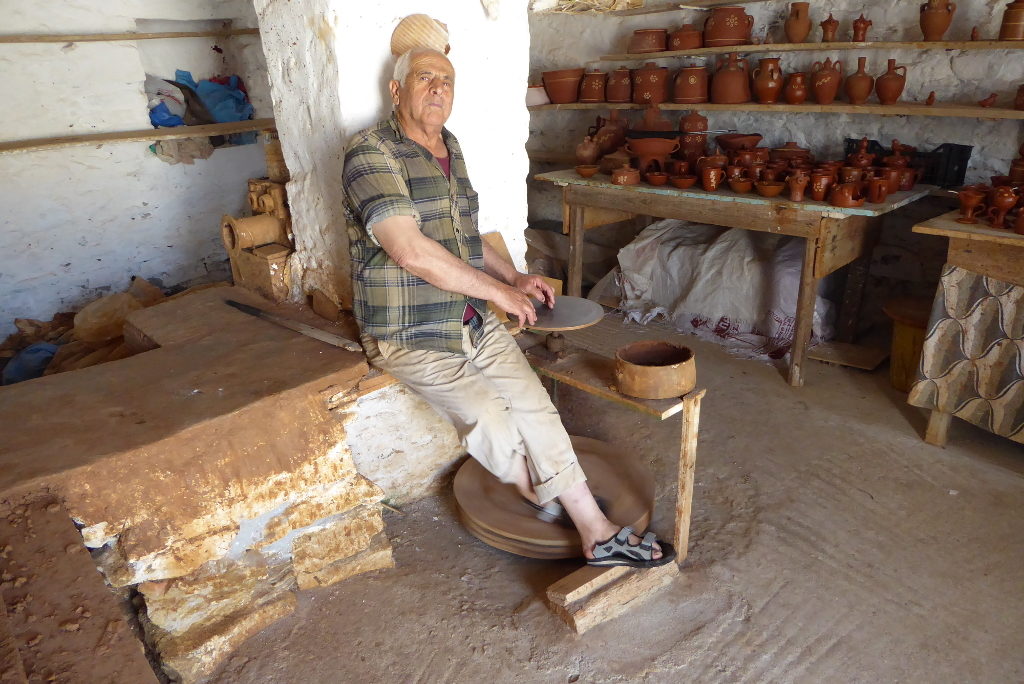
The man in the picture is Kostas Depasta. He’s a Sifniote potter – has been all his life – he’s the real deal!
Today he made me very happy – but he doesn’t fully understand why.
The background story
In the early hours of Wednesday December 5th 1885, Theodore and Mabel Bent came ashore at the northen tip of the island of Sifnos after an horrendous 8-hour crossing from neighbouring Serifos, less than 15km across the strait. Their small caique was captained by Georgios Hadgi Nikolas Ibelligeka, Captain George to Theodore and Mabel. The couple had come to despise him since their first meeting on Serifos and, true to form, he had prevaricated about sailing that day, inventing all sorts of reasons not to go:
Captain George having previously told us that his boat was ready; but it was not, the canvas bulwarks were not even nailed on. His eloquence now took the form of inventing one futile excuse after another; there was no oil, no bread for the men, and these things must be fetched from the town. Everyone, of course, took his side, and we, poor foreigners, had to exercise all our firmness. We told him to dance on his plate, an expression in vogue for quickness. We positively refused to enter the house they proposed that we should spend the night in. Three whole hours we consumed thus idly, and at last, at four o’clock, when it was really getting late, Captain George reluctantly consented to start; and as we sailed off for our journey of eight miles with a favourable wind we heard ominous whispers of winter, night, dark, Boreas, calm, whirlwind, and all the terrors that could be invented. Until we were close upon Siphnos the wind was favourable; and, oh! if we had but started an hour earlier all would have been right; as it was, a persistent calm set in, and Siphnos, like St. Brandon’s Isle , hovered for weary dark hours, now before us, now behind us, as we tacked and struggled for a breath of wind.
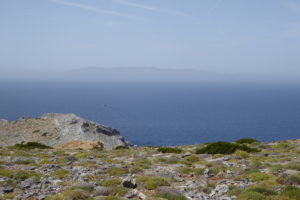
[Sifnos] was reached at last, and with the aid of oars and a fitfully flapping sail we entered the little harbour of Cherónesos [Heronissos] shortly after midnight.
Theodore and Mabel’s intended destination was the main village of Sifnos, called Apollonia, too far to reach at this hour of the night over rough terrain. The only option was to find shelter for the night in Heronissos.
There are only three inhabited houses in this remote little bay to the extreme north of Siphnos: two of these were shut for the winter, and the third, inhabited by an old potter and his wife, opened its door to us, such as it was.
The potter and his wife offered Theodore and Mabel their own, and only, bed, and Theodore spoke extremely warmly of the hospitality extended by this old, poor couple:
From this bed the potter and his wife had just risen: it was formed by some boards fixed into the wall on two sides and supported at the outer angle by the rough trunk of a tree, with one branch left as a step to help you climb the four feet that it was raised from the ground. Some hard woollen sheets and a hairy rug, or ‘ chlamys ’, of home-spun material formed all the covering for these boards
They would take no refusal, poor hospitable old things, so we passed the remainder of the night there as best we could. We liked our old potter very much on further acquaintance: the woman did all she could for us next morning . . . the old couple tried to prepare us a meal, which consisted of fish soup and onions
Back to the present day
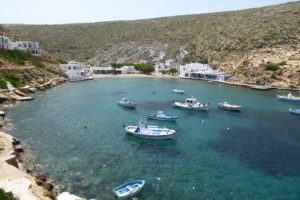
Today, I’d driven up to the fishing hamlet of Heronissos purposely to view the village, the coast and and the nearby monastery described by Theodore. Back then, there were only three houses in the village. Nowadays, it’s somewhat larger but still essentially a small fishing village sustained by some tourism.
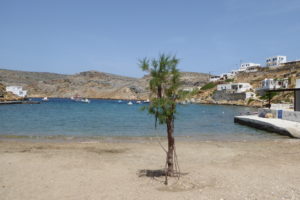
THERE was the beach where Theodore and Mabel had scrambled ashore after their marathon 8-hour crossing, and there, in the corner of the village, just a few metres up from the sea, I noticed a ramshackle building with the roughly-painted sign ‘Keramika‘. ‘Ah‘, I thought, ‘a pottery shop – worth a browse.‘ Sifnos has always been renowned for its pottery and pottery shops are to be found across the island. A couple of years back, the small hotel I was staying in even presented me with a typical piece as a parting gift, which now adorns my kitchen.
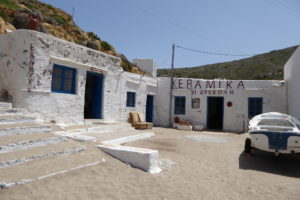
I’d expected nothing more than just another pottery shop but, on entering, I realised this was something different and Theodore’s account started coursing through my mind.
Kostas only speaks Greek so it took me a while to come up with sufficient Greek to put my questions to him, and to understand his answers.
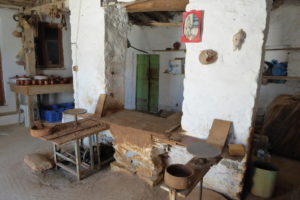
It turns out that his father was a potter, his grandfather was a potter and when I asked whether his father’s father’s father’s father had been a potter and had lived in the same house in 1885, ‘Nai’ was the affirmative answer. I even wrote ‘1885’ on a page in my notebook and showed it to him to be absolutely certain.
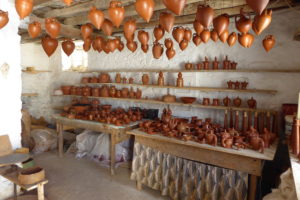
I proudly shook the hand of a man whose great-great-grandfather, I believe, had showed such kindness to Theodore and Mabel on that winter’s night 130 years before. I desparately wanted to relate Theodore’s account to Kostas about the uncharacteristic warmth felt by an over-privileged Englishman toward his humble forebears on that night so long ago. Alas, I was hampered by my poor Greek language skills.
I felt I must take away something made by this descendent of the Bents’ hospitable host. The pot in the picture has some special properties.
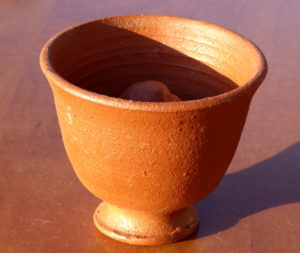
Despite my euphoria at finding Kostas, a doubt niggled at my mind:
And as we sat around the low table the potter told us some of his family troubles: how two of his sons had been burnt in a fire at Constantinople, and how all his daughters had gone to the mainland as cooks; for Siphnos has another speciality besides pots, namely, cooks, and in the Greek restaurants at Constantinople all the chefs are Siphniotes.
How many other sons did the potter have and had they stayed in the island to continue the family tradition? Had his daughters returned from the mainland, married and had children who’d become potters?
I was staying in the port village of Kamares at the family-run Morfeas Pension. I asked Maria about Kostas Depasta but she knew nothing of him. Maria called her ageing father-in-law who immediately confirmed what Kostas had told me – yes, the family had lived in Heronissos for several generations and he believed certainly in the 1800s.
Not absolutely conclusive – but a good way there, I think. Maybe your own investigations might support or refute this connection with the past. Please post a blog message or reply to this post with any additional information you might uncover.
Read more about the lives and travels of Theodore and Mabel Bent at our sister site http://tambent.com.
